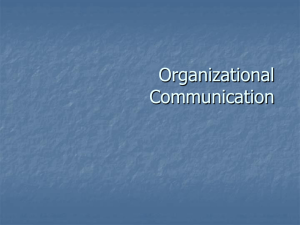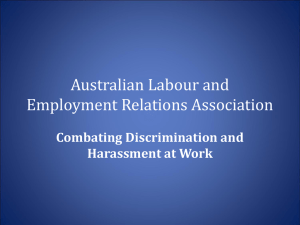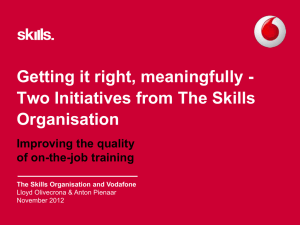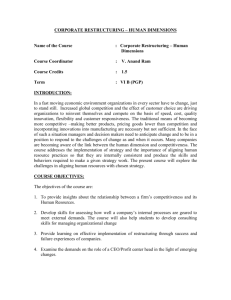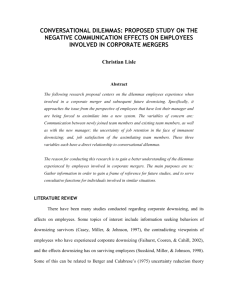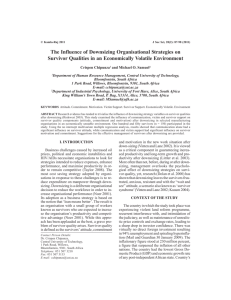Managing Change and Workplace relations
advertisement
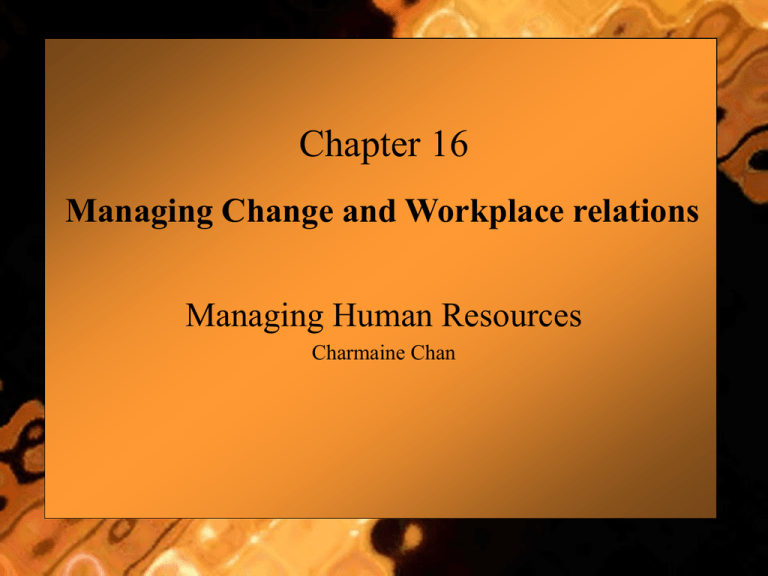
Chapter 16 Managing Change and Workplace relations Managing Human Resources Charmaine Chan 1 What makes a Change? • Casualised work force; lifetime employment is gone; high unemployment; eroded job security; redundant traditional skills; downsizing; predictable work, pay, career, trust and loyalty have gone. • companies are demanding more; job flexibility, multiskilling, employability, TQM, new technology • Increased stress, work-family conflicts, dropping living standards, but people are working longer hours, increasing work effort, intensifying pace of work. • Instead of stability and certainty, now workplace offers change, uncertainty and anxiety. 2 HR Managers as Change Agents HR managers are expected to: introduce new policies and practices change the culture of workplace make organization more responsive, flexible and competitive HR managers continuously monitor organisation’s environment for: – uncertainty (what information is available for accurate decision making?) – volatility (how often is the environment changing?) – magnitude of change (how big are the changes?) – complexity (how many external/internal influences?) – changes in organisational culture (changing employee behaviour requires a change in the organisation’s culture). 3 Steps in the Change Process 1. 2. 3. 4. Determining the needs for change Determining the obstacles to change Implementing change Evaluating change 4 1. Determining the Need for Change • Need become apparent when there is a gap between performance objectives and actual performance. • Indicators such as total net profit, sales per employee, labour costs etc. • Or any decisions to enter new businesses or exit existing business, change will be required. 5 2. Determining Barriers to Change Managers need to identify all potential barriers: Resistance to change at organization, or division or individual level Unions resistance Organization’s existing (bureaucratic?) culture, strategies and structures are powerful barriers Financial ability 6 3. Implementing Change By internal managers or external consultants? Internal managers: – more knowledgeable about people and business operations – often are too narrow in outlook and too imbued with the existing culture to successfully introduce change. External Consultants – Politically neutral and possessing broader and more knowledgeable viewpoints – Generally do not know the organisation and its people. 7 3. Implementing Change (con’t) Top-Down or Bottom-Up Approach? Top-Down: – Involves management deciding on the change and then implementing it. – Emphasis is on speed and action. – Often faces problems in implementation due to the resistance/dissatisfaction of managers and employees. Bottom-up: – Involves considerable discussion and consultation with managers and employees. – Emphasises participation and communication and the minimisation of uncertainty. – Time consuming 8 4. Evaluating change • To measure the effectiveness of change, organizations must compare the before and after situations. • Indicators such as employee productivity, job satisfaction, sales and the like can be used to evaluate the effects of the change. 9 Workplace Change High technology is one of the most important causes of organizational changes. (e.g, introduction of new equipment) sets off a chain of events. – – – – Less skills required A loss of status Carry lower pay rate Less autonomy for workers and unwanted change in reporting relationships Resistance and anger Effectiveness of technological change related to culture and structure of company. 10 Resistance To Change • fear of the unknown– not understanding what is happening or why • disrupted habits– feeling upset when old ways of doing things cannot be continued • loss of confidence– feeling incapable of performing well under the new way of doing things • loss of control– feeling that they are no longer to possess a certain control over some tasks 11 Resistance To Change (con’t) • poor timing– feeling that things are moving too fast • work overload– feeling that physically or mentally unable to handle the change • loss of face– feeling uncomfortable because old ways are no longer perceived as good ways • economic loss– feeling that their pay and benefits may be reduced or that they may lose their job 12 Reducing Resistance to Change Communication Participation guarantees certainty counselling negotiation reward 13 Restructuring Changes: Acquisitions, Mergers, Divestitures Acquisitions: Purchase of a firm by another firm Mergers: Combination of two or more firms to form one new company Divestiture: Selling selected operating units for strategic or financial reasons 14 Restructuring and HR Managing the organisational restructuring is one of the major challenges facing today’s HR manager. Problems faced by HR management during restructuring include: cost of lost talent lost productivity loss of competitive position expense of union problems cost of miscasting people 15 Overcoming Problems of Restructuring ensure a compelling strategic rationale exists for the acquisition or merger move quickly to meld the two companies overcome conflicting corporate cultures create retention incentives for key employees audit the policies and practices of the acquired company ensure the orientation of new employees redesign compensation programs integrate management styles communicate restructuring decisions 16 Downsizing • A reduction in a company’s workforce or job elimination to improve efficiency • A ‘lean and hungry’ organisation rather than a ‘fat and comfortable’ one is the goal. • The elimination of middle management jobs has produced increased spans of control, time pressures and complexity in those supervisory jobs remaining. • Because downsizing involves change, it requires a strategic, proactive approach to human resource management. 17 Downsizing Survivor Syndrome Downsizing may create hardships because of increased stress, fear of unemployment and reduced job opportunities (especially for older workers and for those without marketable skills). Stress caused by anxiety, guilt and fear of job loss in those employees remaining in downsizing organizations (‘survivor syndrome’) HR programs are needed to overcome the aftershock associated with large-scale retrenchments. 18 Making Downsizing Effective: • Target specific inefficiencies, redundancies and low-value activities for elimination. • Retain those who are competent to achieve organisation objectives • Treat employees who lose their jobs with compassion. • Promote open and frequent communications to encourage employees involvement in change process. • Generate excitement about the future by creating a vision. • Detail plan and link it to the organisation’s strategic business objectives to ensure having the right people in place after the downsizing is completed. 19 How HR Can Help Managers Ten basic principles that HR professionals can use to lay off or eliminate employees in a respectful way. 1. Conduct the meeting in private. 2. Keep the meeting short and to the point. 3. Offer support and compassion. 4. Explain why the company made the decision. 5. Don’t make discriminatory statements. 6. Control your emotions. 7. Give the severance package in writing. 8. Encourage the employee to be positive. 9. Plan a graceful exit. 10.Inform other employees, customers and suppliers of the decision. 20 Total Quality Management (TQM) • Total quality management (TQM) involves ‘an organisation-wide commitment to continuous improvement and totally meeting customer needs’. • It builds quality into everything - production design,,purchasing, marketing and HR. 21 Results from TQM • an ability to anticipate, meet and exceed customers’ expectations • gaining a competitive advantage via better products and services and improved work processes • gaining management and employee commitment • staying in business 22 Managing Quality • • • • • • • Creating a quality culture Satisfying the customer Championing of TQM by top management Measuring quality Starting with quality Striving for high standards Involving people • Training management and employees in leadership and team building • Recognise that there is no one best way of introducing TQM 23 Workplace Relations • Refer to employer-employee relations in a specific workplace • A company’s strategic HR objectives affect all aspects of workplace relations. • They impact on rates of pay, recruitment, selection, job security, health and safety, employee motivation and employee attitudes towards the company and union membership. 24 Work Climate • Work climate has a direct impact on viability of many HR management activities. • HR managers are important in persuading line managers of the strategic benefits of innovative HRM policies and practices. • Line managers are critical in influencing employee attitudes and in achieving harmonious workplace relations. 25 Bad Workplace Relations = Bad Management • Bad workplace relations may lead to: demarcation, strikes, go slows, reduced productivity • Remote, faceless managers foster negative solidarity - ‘us against the company’ Good Workplace Relations = Good Management • Good industrial relations centres on leadership, communication, understanding, trust, cooperation and mutual commitment to shared objectives. • Managers who genuinely spread the believe that ‘people are the company’s most important asset’. 26 Successful Management Action in Workplace developing HR values and strategies that deliver management's approach to people management encouraging open communication and being prepared to listen ensuring that managers are out of their offices and give employees personal attention ensuring that front line supervisors are trained and have the necessary authority and rewards to make them feel part of management 27 Successful Management Action Workplace recognising loyalty and seniority objectively identifying and rewarding performance creating a pleasant and safe physical work environment encouraging the development of employee skills by ongoing training and development ensuring fair and competitive compensation and benefits communicating to employees that management is committed to treating employees fairly and with respect. 28 Salaried Operations • Involves all employees being treated equally as staff rather than as staff and wages personnel • Promote the mutual interests of employees and the organisation, are treated as staff rather than as staff and wages personnel. • Aims to remove artificial barriers by using cooperative effort and to ensure employees are given equal respect and treatment • Emphasising the creation of a more productive, efficient and competitive organisation by enhancing employee commitment and competence 29 Salaried Operations (con’t) • Achieved by: – Status symbols (e.g. reserved parking, separate canteens) and different policies for staff personnel, treat them as first second class citizens – Rewards based on individual efforts and achievement – Emphasis on multiskilling – High pay and fringe benefits – Well trained supervisors with confidence and know how to manage HR – Decision making is pushed down to the lowest level to promote individual responsibility and reduce the need for supervision 30


